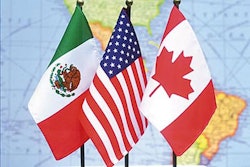During a tumultuous marketing year disrupted by COVID-19, the importance of the market access, stability and transparency laid out in a free trade agreements (FTAs) cannot be understated. Before and during the coronavirus pandemic, analysis by the U.S. Grains Council (USGC) of the export trade data provided by the U.S. Department of Agriculture (USDA) demonstrates how trade agreements have driven the exports of U.S. grain in all forms (GIAF) – and suggests how future trade policy with markets with potential growth could drive U.S. agriculture’s prosperity
The GIAF calculation offers a holistic view of feed grain sold to overseas customers in both unprocessed and value-added forms. This calculation includes corn-equivalent exports of U.S. corn, sorghum, barley, distiller’s dried grains with solubles (DDGS), ethanol, corn gluten meal (CGM), meat and poultry.
The contrast in GIAF sales to FTA and non-FTA markets shows the result of preferential trade terms included in these agreements and long-term market development work by organizations like USGC. The trading partners included in the 14 FTAs the United States has in place with 20 countries continue to represent some of the largest and most loyal customers for U.S. corn, sorghum, barley, ethanol, distiller’s dried grains with solubles (DDGS), corn gluten feed/meal and other co-products. New trade pacts with Japan and China that are not full FTAs also show the importance of those markets and having increasingly better access to them for export growth.
The 20 U.S. FTA partners purchased 59.4 million metric tons (2.34 billion bushels in corn equivalent) of U.S. GIAF in the 2018/2019 marketing year, representing 55 percent of total GIAF exports. That slice of the overall demand pie stayed consistent in the first six months of the 2019/2020 marketing year, the latest data available, with FTA partners purchasing 56 percent of U.S. GIAF exports, equal to 24.7 million tons (972 million bushels in corn equivalent).
The enduring strength of demand from FTA partners once again demonstrates the importance of the market access provided by these agreements.
North American Trading Partners Continue to Top FTA List
Mexico and Canada continue to represent the largest FTA trading partners, thanks to geographic proximity and duty-free access provided by the North American Free Trade Agreement (NAFTA) and maintained in the United States-Mexico-Canada Agreement (USMCA). Since the FTA’s inception in 1994, U.S. agricultural exports to Canada and Mexico tripled and quintupled, respectively, bolstered by these comparative advantages, well-developed North American supply chains and robust market development work by USGC and its members.
By the end of the 2018/2019 marketing year, Mexico had increased U.S. GIAF purchases to 25.6 million metric tons (equivalent to one billion bushels). Those purchases included a record high for U.S. corn exports for the fifth year in a row, increased purchases of U.S. barley and ethanol along with steady U.S. DDGS purchases.
Canada also set a new record for U.S. GIAF purchases in 2018/2019 at 8.03 million metric tons (316 million bushels), led by steady purchases of U.S. ethanol and increased buying of U.S. corn and DDGS.
In the current marketing year, Mexico continues to rank as the top market for U.S. corn, barley and DDGS, the second largest U.S. sorghum market and the ninth largest U.S. ethanol market. Canada is the second largest U.S. ethanol buyer, second largest U.S. barley buyer, fourth largest corn buyer and seventh largest U.S. DDGS buyer.
Central American Buyers Represent Growing Demand For U.S. GIAF
Proximity of Central American markets also facilitates the movement of U.S. agricultural goods, supported by market access advantages built into the Dominican Republic-Central America Free Trade Agreement (CAFTA-DR).
CAFTA-DR is a regional free trade agreement between the United States and Central American trading partners – Costa Rica, El Salvador, Guatemala, Honduras, Nicaragua and the Dominican Republic. The agreement allows favorable tariff treatment for more than 95 percent of U.S. agricultural products, including corn.
The agreement entered into force in 2006, and USGC has since worked to emphasize the U.S. origin advantages to regional buyers and end-users. As a result, U.S. corn exports to CAFTA-DR countries have increased more than three-fold since the agreement went into effect.
Three of these markets – Guatemala, Honduras and Costa Rica – all rank in the top 10 U.S. corn buyers for the 2019/2020 marketing year, thus far, continuing growth from 2018/2019. Guatemala ranked as the eighth largest buyer at 1.22 million tons (48 million bushels) in 2018/2019, the first time the country purchased more than one million tons. Costa Rica continued an upward streak for the last four marketing years, purchasing 885,000 metric tons (34.8 million bushels) in 2018/2019.
New Japan Agreement Strengthens Trade With U.S. Farmers, Agribusinesses
The U.S.-Japan Trade Agreement, which went into effect on Jan. 1, 2020, is not a comprehensive free trade agreement, but does provide important market access provisions for U.S. coarse grains, co-products and ethanol.
The agreement solidifies trade with Japan by maintaining a zero duty on imports of corn for feed and eliminating a 3 percent tariff for corn other than feed. Japan will also eliminate U.S. sorghum tariffs, which are as high as 3 percent, and reduce a mark-up on barley for feed. It also includes a staged reduction for U.S. ethanol and U.S. corn, barley and sorghum flour and preserves duty-free market access for U.S. feed and food corn, corn gluten feed and DDGS.
Thus far in the 2019/2020 marketing year, Japan ranks as the second largest market for U.S. corn, third largest market for U.S. barley/barley products, fourth largest market for U.S. sorghum and sixth largest market for U.S. DDGS. If these purchases were added to the FTA trading partner total, it would further strengthen the market share offered by the closest of U.S. grains’ buyers.
Looking Ahead
Free trade agreements offer tariff preferences, which are critical and valuable to U.S. producers. They also establish trading norms that keep grain flowing even during times of crisis like COVID-19. Importantly, FTAs and more limited agreements like those put in place with Japan and China over the last year are also the foundation of market development work and relationship building done by organizations like the Grains Council – which pays off during confusing and trying times.
Since early March, the entirety of the grain supply chain – from the farmer to the export channel to the end-user – have collaborated to maintain operations as feasible, provide regular updates and put trust in each other to ensure work to together continues throughout the crisis. The outcomes of this work will be apparent in future trade numbers as well as relationships re-solidified with key partners on which we will build in a post-COVID world.
Follow along as the 2019/2020 marketing year progresses with the Feed Grains In All Forms portal at grains.org, where USGC tracks U.S. exports of U.S. coarse grains, co-products, ethanol and meat equivalents on a monthly basis. The interactive resource also converts these exported volumes into corn equivalents, which offers a holistic view of the amount of U.S. feed grains consumed by overseas customers.















